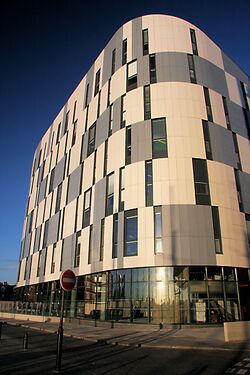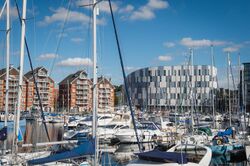University of Suffolk
Topic: Organization
 From HandWiki - Reading time: 7 min
From HandWiki - Reading time: 7 min
 | |
| Type | Public |
|---|---|
| Established | 2007 – University Campus Suffolk 2016 – renamed to University of Suffolk after gaining independence |
Academic affiliation | University of East Anglia University of Essex West Suffolk College East Coast College Universities UK Suffolk New College |
| Chancellor | Helen Pankhurst CBE |
| Vice-Chancellor | Helen Langton |
| Students | 7,695 (2018/19)[1] |
| Undergraduates | 7,080 (2018/19)[1] |
| Postgraduates | 610 (2018/19)[1] |
| Location | Ipswich, and other campuses serving foundation courses around Suffolk and in Norfolk , |
| Grey & gold|u}}rs | Grey & gold |
| Website | {{{1}}} |
The University of Suffolk is a public university situated in Suffolk and Norfolk, England . The university was established in 2007 as University Campus Suffolk (UCS), founded as a collaboration between the University of East Anglia and the University of Essex.[2] The university's current name was adopted after it was granted independence in 2016 by the Privy Council and was awarded university status.[3][4][5][6]
The University of Suffolk is spread over four campuses: a central hub in Ipswich and campuses located in Bury St Edmunds, Lowestoft and Great Yarmouth (the latter in Norfolk, not Suffolk) focusing on foundation courses .[7] The university operates six academic faculties and in 2018/19 had 7,695 students. Of the total, 8% are identified as international students, 53% as mature students, and 66% of the university's students are female.[8]
The university secured the 8th place among UK universities in the "Course and Lecturers" category according to the WhatUni Student Choice Awards 2019.[9]
The current chancellor of the University of Suffolk is Helen Pankhurst, great-granddaughter of Emmeline Pankhurst, who is an appointed Commander of the Order of the British Empire (CBE), as well as a scholar and writer.[10]
History
In 2003 Suffolk County Council established a "stakeholder group" to investigate the possibility of establishing a university in the county. Suffolk was the largest English county that did not host a university.[11] The group included representatives from the University of East Anglia, the University of Essex, West Suffolk College, the East of England Development Agency, the Higher Education Funding Council for England, Suffolk Learning and Skills Council, Suffolk County Council, Ipswich Borough Council, Suffolk Chief Executive's Group and the Suffolk Development Agency.
Following funding pledges from Ipswich Borough Council and Suffolk County Council in 2004, the plan was backed by the Higher Education Funding Council for England (HEFCE) with £15m worth of funding in 2005 and attracted a £12.5m grant from the East of England Development Agency in 2006[11] The institution was officially launched under the name 'University Campus Suffolk' on 1 August 2007[5][12] and welcomed its first students in September of the same year.[13]
Because UCS did not have degree-awarding powers, its students received their degrees from either the University of East Anglia or the University of Essex via a cooperative agreement.[13] The institution was later granted degree-awarding powers by the Quality Assurance Agency for Higher Education in November 2015, and in May 2016 it was awarded University status by the Privy Council. As a consequence, UCS was renamed The University of Suffolk in August 2016 and began awarding degrees in its own right.[3][4]
Campuses
Ipswich
The University of Suffolk's main hub is located in Ipswich on the historical Ipswich Waterfront. The Ipswich campus is spread across a compact area on the Waterfront with various university buildings. The principal university building is known simply as the Waterfront Building and was designed by RMJM Architects,[14] the Waterfront Building was opened in September 2008 and cost £35 million to build.[15][16] It has three lecture halls and 34 smaller teaching rooms.[17]
The six-storey James Hehir Building was officially opened in March 2011 at a cost of £21 million[18] It is named after the former chief executive of Ipswich Borough Council and includes Cult Cafe. Campus North houses the library or "Learning Resource Centre".[17] Onsite student accommodation is provided in the 600-room Athena Hall, located adjacent to the James Hehir building.[6]
The most recent addition to the growing campus is The Hold, which houses the majority of the Suffolk Record Office's collection and provides various facilities to the university including a lecture hall.[citation needed]
The Ipswich campus offers a range of undergraduate and postgraduate courses, including Art and Design, Business Management, Computing, Education, Film, Law, Nursing and Midwifery.[citation needed]
Great Yarmouth
The Great Yarmouth centre is located at the Southtown site of East Coast College in neighbouring Norfolk.[5] Subjects such as Computing, Counselling, Engineering, Fashion, Music, and Photography are available at the centre, which has a modern recording studio.[5][17]
Lowestoft
The Lowestoft Centre is located at the site of East Coast College. Lowestoft offers degrees in Children's Care, Learning and Development, Design, Inclusive Practice and Integrated Working, Operations Engineering, Supporting Inclusive Learning and Practice, and Social Science.[citation needed]
Partnerships
The University of Suffolk has partnered with two Further Education colleges, East Coast College and Suffolk New College, that serve students in the Suffolk area. It also has partnerships with the Global Banking School, London School of Commerce, Unicaf, and Unitas, an education charity specialising in criminal justice.[19]
Organisation and administration
Faculties and departments
The university is split into four schools, each facilitating various courses.
• School of Social Sciences and Humanities.[citation needed]
• Suffolk Business School.[citation needed]
• School of Health and Sports Sciences.[citation needed]
• School of Engineering, Arts, Science and Technology – EAST.[citation needed]
East Contemporary Art Collection
The University of Suffolk houses the "East Contemporary Art Collection",[20] which is exhibited at the Waterfront Gallery.[21] Founded by artists Robert Priseman and Simon Carter in 2013 the "East Contemporary Art Collection" contains 160 works of art by 115 artists[22] and was formed to make the first public collection of contemporary art in the East of England.[23]
Artists represented in the collection all have a working connection with the seven east of England counties of Suffolk, Norfolk, Essex, Cambridgeshire, Lincolnshire, Bedfordshire and Hertfordshire; the list of artists includesMaggi Hambling, Amanda Ansell, Susan Gunn, Nicholas Middleton, Justin Partyka, Anne Schwegmann-Fielding, James Dodds, Linda Ingham, Stephen Newton and Mary Webb.[24] The works of art in the collection were all produced after the year 2000 and are designed to be available for public display and as a learning resource for the university and students from the wider educational community.[25]
Sustainability
The university operates as a "Centre for Applied sustainability". The development of the Phase 1 campus was assessed as BREEAM Excellent, representing "best practice in sustainable development".[26]
The university is also engaged in the New Anglia Local Enterprise Partnership Green Economy Pathfinder.[citation needed]
Student life
Student housing
The on-campus halls of residence, Athena Hall, is located on the Ipswich Waterfront and houses up to 590 students. There is currently no accredited accommodation for the partner colleges in Bury St Edmunds, Great Yarmouth and Lowestoft.[citation needed]
Union
The Union was formed on 1 August 2007, the same day the university was officially launched. The union represents the student body at the management level and it is composed of paid and unpaid students who are based at the Union office in the campus's East building. It provides support for its students and manages the university social calendar, with multiple events run during the academic weeks and special Freshers weeks at the beginning of each academic year.[citation needed]
The president and vice-president of the Union are elected every March from candidates from the student body; they take office for 12 months from July to July, overseeing the totality of one academic year. There is a current two-year maximum term for the positions. The current president is Daniel Goulborn and the vice-president is Mauro Cardoso, both newly elected for 2020.[citation needed]
Academic profile
| National rankings | |
|---|---|
| Complete (2021)[27] | 80= |
| Guardian (2021)[28] | 67 |
| Times / Sunday Times (2021)[29] | 105 |
| Global rankings | |
| British Government assessment | |
| Teaching Excellence Framework[30] | Bronze |
The University of Suffolk s a recently established university in the UK. Its current national ranking is low, however it has seen a rising number of new students from the UK and abroad. The university was ranked in the top 10 for Course and Lecturers in the WhatUni Student Choice Awards 2019, which was based on a survey of over 41,000 students nationwide, rising 60 places from the previous year.[31][better source needed]
Notable alumni
- Leila Lopes – Miss Universe 2011
References
- ↑ 1.0 1.1 1.2 "Where do HE students study?". Higher Education Statistics Agency. https://www.hesa.ac.uk/data-and-analysis/students/where-study. Retrieved 1 March 2020.
- ↑ Anonymous (4 July 2016). "University Campus Suffolk gains approval to become the University of Suffolk" (in en). https://www.uos.ac.uk/news/university-campus-suffolk-gains-approval-become-university-suffolk.
- ↑ 3.0 3.1 "University Campus Suffolk gains independence". BBC. 17 May 2016. https://www.bbc.co.uk/news/uk-england-suffolk-36307221.
- ↑ 4.0 4.1 Anonymous (4 July 2016). "University Campus Suffolk gains approval to become the University of Suffolk". https://www.ucs.ac.uk/About/News/2016/20160517_University-Campus-Suffolk-gains-approval-to-become-the-University-of-Suffolk.aspx.
- ↑ 5.0 5.1 5.2 5.3 University Campus Suffolk , University of Essex. Retrieved 28 September 2012.
- ↑ 6.0 6.1 University Campus Suffolk guide, Daily Telegraph, 21 June 2011. Retrieved 28 September 2012.
- ↑ University Campus Suffolk, University of East Anglia. Retrieved 28 September 2012.
- ↑ "University of Suffolk (S82) - Which? University". http://university.which.co.uk/university-campus-suffolk-s82.
- ↑ "Best Universities 2019 | UK University Rankings by Whatuni". https://www.whatuni.com/degrees/student-awards-winners/2019.html.
- ↑ Pankhurst, Helen (2012-08-21). "Women's rights run in my veins, so I'll be joining a new march on parliament" (in en-GB). The Guardian. ISSN 0261-3077. https://www.theguardian.com/commentisfree/2012/aug/21/women-rights-march-on-parliament.
- ↑ 11.0 11.1 University plan wins £12.5m grant, BBC News, 20 March 2006. Retrieved 28 September 2012.
- ↑ New university officially opened, BBC News, 1 August 2007. Retrieved 28 September 2012.
- ↑ 13.0 13.1 University open to first students, BBC News, 10 September 2007. Retrieved 28 September 2012.
- ↑ New views of dockside campus plan, BBC news website, 3 August 2006. Retrieved 28 September 2012.
- ↑ University Campus Suffolk (UCS), The Independent Freshers Guide, 2012, 3 August 2012. Retrieved 28 September 2012.
- ↑ Flagship university building open, BBC news website, 29 September 2008. Retrieved 28 September 2012.
- ↑ 17.0 17.1 17.2 University guide 2013 University Campus Suffolk, The Guardian, 31 May 2012. Retrieved 29 September 2012.
- ↑ UCS opens £21m James Hehir Building in Ipswich, BBC news website, 27 January 2011. Retrieved 28 September 2012.
- ↑ "Our Partners". https://www.uos.ac.uk/our-partners.
- ↑ "East Contemporary Art Collection". Art UK. https://artuk.org/discover/artworks/search/collection:east-contemporary-art-collection-2756/page/2.
- ↑ "Waterfront Gallery, UCS". Culture 24. http://www.culture24.org.uk/am543916.
- ↑ "Art Collection to go on Public Display at University Campus Suffolk". Newswire. 11 September 2013. http://www.prnewswire.co.uk/news-releases/275000-art-collection-to-go-on-public-display-at-university-campus-suffolk-223251141.html.
- ↑ "East of England Contemporary Art Collection". Artist and Illustrator. 11 September 2013. https://www.artistsandillustrators.co.uk/news/contemporary/986/duo-launch-first-east-of-england-contemporary-art-collection.
- ↑ "On display at Ipswich Waterfront". Ipswich Star. 1 October 2013. http://www.ipswichstar.co.uk/news/new-contemporary-art-275-000-collection-on-display-at-ipswich-waterfront-1-2828285.
- ↑ "East Contemporary Art Trip". One Sixth Form College. 8 October 2013. https://www.suffolkone.ac.uk/information/news/east-contemporary-art-trip/.
- ↑ "News story, 2008". http://www.ucs.ac.uk/about/News/2008/pr17032008.aspx.
- ↑ "University League Table 2021". The Complete University Guide. 1 June 2020. http://www.thecompleteuniversityguide.co.uk/league-tables/rankings.
- ↑ "University league tables 2021". The Guardian. 5 September 2020. https://www.theguardian.com/education/ng-interactive/2020/sep/05/the-best-uk-universities-2021-league-table.
- ↑ "The Times and Sunday Times University Good University Guide 2021". Times Newspapers. http://nuk-tnl-editorial-prod-staticassets.s3.amazonaws.com/2016/bespoke/university-guide/index.html.
- ↑ "Teaching Excellence Framework outcomes". Higher Education Funding Council for England. https://www.officeforstudents.org.uk/advice-and-guidance/teaching/tef-outcomes/.
- ↑ Sandalls, Katy (8 March 2019). "University of Suffolk shortlisted for award" (in en-UK). https://www.ipswichstar.co.uk/news/whatuni-student-choice-award-shortlisting-for-university-of-suffolk-2836114.
External links
[ ⚑ ] 52°03′09″N 1°09′49″E / 52.0525°N 1.1635°E
 |
 KSF
KSF

